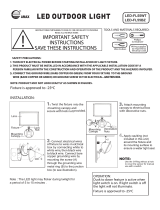
2
5($' $1' 6 $ 9 ( 7+(6( ,16758&7,216
%HIRUH EHJLQQLQJ LQVWDOODWLRQ
RI\RXU QHZ
FHLOLQJ
IDQ
UHDG DQG IROORZWKHVH VDIHW\SUHFDXWLRQV,I\RX DUHQRWIDPLOLDU
ZLWKQDWLRQDODQGORFDOHOHFWULFDOFRGHVDQGEDVLFHOHFWULFDO
ZLULQJ
SURFHGXUHV
ZH UHFRPPHQG
WKDW\RX KDYH DTXDOLILHG
HOHFWULFLDQ
LQVWDOO
\RXU QHZ FHLOLQJ
IDQ
Before you begin, TURN OFF THE ELECTRICITY. Determine which cir-
cuit your new fan will be using and remove the fuse or turn off the circuit
breaker at the main electrical panel.
Make sure that all wiring conforms to national and local electrical codes. If
you are in question, obtain a copy of the codes and wire the fan according-
ly. Never leave bare wires uncovered (wire connection), use wire nuts to
cap all connections. Plastic electrical tape is not recommended.
When working with electricity, never take short cuts. Follow the code in
every respect. Basic requirements for a ceiling fan installed with lights are,
120 volts AC - 60Hz, on a grounded circuit with a 15 amp breaker or fuse.
Make sure that your electrical system and choice of location meet these
requirements.
If the location where you plan to install your fan does not already have an
electrical outlet, hire a licensed electrician to run the wiring and install an
outlet box designed for ceiling fans or heavy fixtures. The outlet box
should be able to support a minimum moving weight of 50 pounds and
marked “Acceptable for Fan Support” (Plastic outlet boxes are not recom-
mended for ceiling fan installation).
If you plan to use an existing electrical location, check to make sure that the
outlet box is not PLASTIC, that it is securely attached and able to support
at least 50 pounds of moving weight and marked “Acceptable for Fan
Support”. If you have any questions, outlet boxes and support systems for
ceiling fans are available at most hardware and do-it-yourself centers. In
most cases, your
dealer will have all the necessary products
for the proper
and safe installation of your ceiling fan.
The location you choose should have a minimum clearance of 20 inches
from any wall to the blade tip at any point in its rotation and a minimum of
7 feet from blade level to floor and 10 inches from the blades.
















